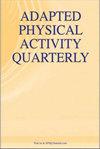Exploring the Relationship Between Quality and Quantity of Physical Activity Participation in Community-Based Exercise Programs for Persons With Physical Disabilities.
IF 1.7
3区 医学
Q2 REHABILITATION
引用次数: 2
Abstract
Community-based exercise programs for persons with disabilities promote greater quantity of leisure-time physical activity (LTPA) participation among their members, perhaps because of the quality experiences fostered by the program. This study aimed to explore the relationship between quality and quantity of physical activity participation in the context of community-based exercise programming and the role that gender plays in this relationship. Adults with physical disabilities (N = 91; Mage = 55, 49 men) from three community-based exercise programs across Canada completed a survey asking about quality participation (Measure of Experiential Aspects of Participation [MeEAP]) and LTPA. Structural equation modeling was used to examine the relationship between MeEAP scores and LTPA. Quality participation was not related to LTPA, even with gender included as a moderator. Men reported higher levels of LTPA and quality participation than women, highlighting gender differences that should be considered when researching and designing exercise programs for individuals with disabilities.以社区为基础的肢体障碍者运动项目中身体活动参与质量与数量的关系探讨。
以社区为基础的残疾人运动项目促进了其成员更多的休闲时间体育活动(LTPA)的参与,也许是因为该项目培养了高质量的经验。本研究旨在探讨以社区为基础的运动规划背景下体育活动参与的质量和数量之间的关系,以及性别在这种关系中所起的作用。身体残疾成人(N = 91;来自加拿大三个社区运动项目的55,49名男性完成了一项关于参与质量的调查(参与体验方面的测量[MeEAP])和LTPA。采用结构方程模型检验MeEAP得分与LTPA之间的关系。质量参与与LTPA无关,即使将性别作为调节因素考虑在内。男性报告的LTPA水平和参与质量都高于女性,这突出了在研究和设计残疾人锻炼计划时应考虑到的性别差异。
本文章由计算机程序翻译,如有差异,请以英文原文为准。
求助全文
约1分钟内获得全文
求助全文
来源期刊
CiteScore
3.00
自引率
10.50%
发文量
26
审稿时长
>12 weeks
期刊介绍:
APAQ is an international, peer-reviewed, multidisciplinary journal designed to stimulate and communicate scholarly inquiry relating to physical activity that is adapted in order to enable and enhance performance and participation in people with disability. Physical activity implies fine, gross, functional, and interpretive movement including physical education, recreation, exercise, sport, and dance. The focus of adaptation may be the activity or task that is to be performed, environment and facilities, equipment, instructional methodology, and/or rules governing the performance setting. Among the populations considered are persons with motor, intellectual, sensory, and mental or other disabilities across the life span. Disciplines from which scholarship to this aim may originate include, but are not limited to, physical education, teacher preparation, human development, motor behavior and learning, biomechanics, exercise and sport physiology, and exercise and sport psychology. Scientific inquiry may originate from quantitative or qualitative inquiry, as well as from multimethod designs.

 求助内容:
求助内容: 应助结果提醒方式:
应助结果提醒方式:


